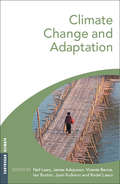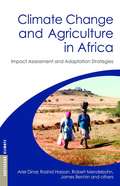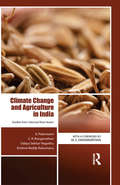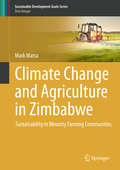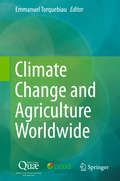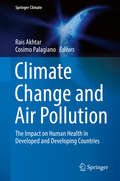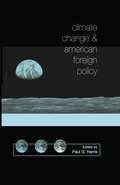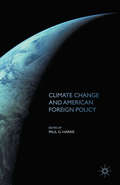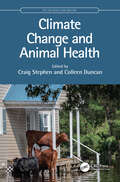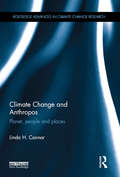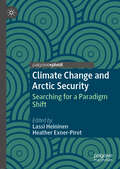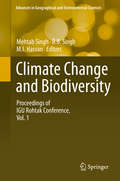- Table View
- List View
Climate Change Adaptation Manual: Lessons learned from European and other industrialised countries
by Andrea Prutsch Torsten Grothmann Sabine McCallum Inke Schauser Rob SwartDue to the lack of success in climate change mitigation efforts, the importance of adaptation is becoming more and more apparent and is now one of the main imperatives of international research and action. However, research on adaptation is mostly not directly applicable to adaptation policy or practice, leaving a gap between scientific results and practical advice for decision makers and planners. This book seeks to address this problem and bridge the gap and should provide readers with practical and applicable information on climate change adaptation. Following an introduction, the book is organised into four main sections, each reflecting an essential component in the adaptation process. Climate change adaptation is an emerging subject area and has gained increased political and academic attention within the last decade. Whereas most books in the field focus on adaptation in developing countries, this volume provides an examination of predominantly European policy and offers inter-disciplinary insight into cutting edge knowledge and lessons learnt in a relatively new field of implementation.
Climate Change Adaptation Manual: Lessons learned from European and other industrialised countries
by Andrea Prutsch Torsten Grothmann Sabine McCallum Inke Schauser Rob SwartDue to the lack of success in climate change mitigation efforts, the importance of adaptation is becoming more and more apparent and is now one of the main imperatives of international research and action. However, research on adaptation is mostly not directly applicable to adaptation policy or practice, leaving a gap between scientific results and practical advice for decision makers and planners. This book seeks to address this problem and bridge the gap and should provide readers with practical and applicable information on climate change adaptation. Following an introduction, the book is organised into four main sections, each reflecting an essential component in the adaptation process. Climate change adaptation is an emerging subject area and has gained increased political and academic attention within the last decade. Whereas most books in the field focus on adaptation in developing countries, this volume provides an examination of predominantly European policy and offers inter-disciplinary insight into cutting edge knowledge and lessons learnt in a relatively new field of implementation.
Climate Change Adaptation Measures in Vietnam: Development and Implementation (SpringerBriefs in Earth Sciences)
by Philipp Schmidt-Thomé Thi Ha Nguyen Thanh Long Pham Jaana Jarva Kristiina NuottimäkiThis book describes the iterative steps that were successfully undertaken to develop adaptation measures to climate change in two Vietnamese provinces. The methodology used to develop the scientific basis and the societal agreement of the need to adapt to climate change is applicable also to other regions in Vietnam, Asia and worldwide.The uncertainties of climate change models make it difficult to justify investments to finance protection from uncertain impacts. Setting out with the projected climate change impacts in Vietnam, which is one of the most vulnerable countries to climate change, the book describes a methodological approach to assess and evaluate local vulnerabilities of natural resources to climate change and socio-economic impacts, engaging local stakeholders in the development of locally acceptable and economically feasible adaptation measures. The methodological approach to understand the vulnerabilities and to develop climate change adaptation measures was scenario workshops that supported the communication between scientists and stakeholders.The development of climate change adaptation strategies is nearly state-of-the-art in many countries, but often there is still a large step towards implementing climate change adaptation measures on the local level. The challenge in the development of adaptation measures lies in their acceptability by local stakeholders and decision makers. Climate change adaptation measures also usually demand investments. To understand potential future risks the communication methodology was to first get a good understanding of the natural resources (mainly surface and groundwater) and their potential vulnerabilities (current and future). This was followed by developing a common understanding of current risk patterns, as well as underlying vulnerabilities and hazards. Socio-economic developments have an equally strong, and in the short term mostly even stronger, impact on the living environment and natural resources as long-term climate change impacts. The scenario workshops developed a holistic approach on current and potential future risk patterns, with a special focus on surface and groundwater quantities and qualities, natural hazards and sea level rise. Land-use planning was identified as playing a decisive role in minimizing current and future risks. Finally, first adaptation measures for two Vietnamese provinces were developed and shall be implemented over the next years. The methodology that led to these adaptation measures shall be applied in other Vietnamese provinces.
Climate Change Adaptation, Resilience and Hazards (Climate Change Management)
by Walter Leal Filho Haruna Musa Gina Cavan Paul O'Hare Julia SeixasThis book analyses the links between climate change adaptation, resilience and the impacts of hazards. The contributors cover topics such as climate change adaptation in coastal zones, the evaluation of community land models, climate change considerations in public health and water resource management, as well as conceptual frameworks for understanding vulnerabilities to extreme climate events. The book focuses on a variety of concrete projects, initiatives and strategies currently being implemented across the world. It also presents case studies, trends, data and projects that illustrate how cities, communities and regions have been striving to achieve resilience and have handled hazards.
Climate Change Adaptation Strategies – An Upstream-downstream Perspective: An Upstream-downstream Perspective
by Nadine Salzmann Christian Huggel Samuel U. Nussbaumer Gina ZiervogelClimate change and the related adverse impacts are among the greatest challenges facing humankind during the coming decades. Even with a significant reduction of anthropogenic greenhouse gas emissions, it will be inevitable for societies to adapt to new climatic conditions and associated impacts and risks. This book offers insights to first experiences of developing and implementing adaptation measures, with a particular focus on mountain environments and the adjacent downstream areas. It provides a comprehensive ‘state-of-the-art’ of climate change adaptation in these areas through the collection and evaluation of knowledge from several local and regional case studies and by offering new expertise and insights at the global level. As such, the book is an important source for scientists, practitioners and decision makers alike, who are working in the field of climate change adaptation and towards sustainable development in the sense of the Paris Agreement and the Agenda 2030.
Climate Change, Agriculture and Rural Livelihoods in Developing Countries (Advances in Asian Human-Environmental Research)
by Keshav Lall Maharjan Niraj Prakash JoshiThis book is about climate change and its relation to agriculture and rural livelihoods. It starts by providing a basic understanding of climate change science followed by the relation of climate change to agriculture, the impact of which is discussed based on the particular impact of climate change on plant and animal physiology. The book further discusses the inclusion of the agriculture sector in various international climate change negotiations. It also reviews the cost and opportunities for agricultural projects through international climate change regimes, specifically the Clean Development Mechanism under the Kyoto Protocol. With this background, the book finally proceeds to an explanation of the methodologies used to assess the impact of climate change on agriculture and empirically discusses its impact on agriculture and rural livelihoods in Nepal.
Climate Change Alleviation for Sustainable Progression: Floristic Prospects and Arboreal Avenues as a Viable Sequestration Tool
by Moonisa Aslam Dervash Akhlaq Amin WaniThe change in climatic conditions has resulted in a series of events from the melting of polar ice to the rising of sea levels. This has affected low-lying coastal areas by endangering plants and animals, agriculture and livelihood patterns in general, not to mention causing the outbreak of diseases like dengue, malaria, etc. It is, thus, imperative that mitigation measures to stabilize or reduce the concentration of carbon dioxide is brought about. A key step is the bio-fixation of carbon from the atmosphere. This book attempts to bring forth the role of vegetation in carbon sequestration. The introductory chapters of the book deal with the understanding of the physical attributes governing climate on earth, historical account of climate change, impacts of climate change on different environs and eco-strategies to combat climate change. Detailed account of mechanism of carbon sources and sinks, carbon credits and REDD+ are also discussed. A sizeable portion of the book is dedicated to the climate change and phonological variability, clean development mechanism and economic stability through natural resource management. Academicians, researchers, policy makers and environmental stakeholders will find it a useful and comprehensive guide in the floristic and arboreal potential to sequester carbon dioxide and will suffice the diverse needs of teaching and research.
Climate Change Alleviation for Sustainable Progression: Floristic Prospects and Arboreal Avenues as a Viable Sequestration Tool
by Akhlaq Amin WaniThe change in climatic conditions has resulted in a series of events from the melting of polar ice to the rising of sea levels. This has affected low-lying coastal areas by endangering plants and animals, agriculture and livelihood patterns in general, not to mention causing the outbreak of diseases like dengue, malaria, etc. It is, thus, imperative that mitigation measures to stabilize or reduce the concentration of carbon dioxide is brought about. A key step is the bio-fixation of carbon from the atmosphere. This book attempts to bring forth the role of vegetation in carbon sequestration. The introductory chapters of the book deal with the understanding of the physical attributes governing climate on earth, historical account of climate change, impacts of climate change on different environs and eco-strategies to combat climate change. Detailed account of mechanism of carbon sources and sinks, carbon credits and REDD+ are also discussed. A sizeable portion of the book is dedicated to the climate change and phonological variability, clean development mechanism and economic stability through natural resource management. Academicians, researchers, policy makers and environmental stakeholders will find it a useful and comprehensive guide in the floristic and arboreal potential to sequester carbon dioxide and will suffice the diverse needs of teaching and research.
Climate Change and Adaptation
by James Adejuwon Vicente Barros Ian Burton Jyoti Kulkarni Rodel Lasco Neil Leary?This book provides valuable lessons that will improve public policy and the quality of decisions that will affect generations to come.? Richard Moss, Senior Director Climate and Energy, United Nations Foundation ?An excellent addition to the body of knowledge on adaptation to climate change from the developing world, which has been largely missing until now.? Saleemul Huq, Director, Climate Change Programme, International Institute for Environment and Development ?This important volume is a valuable effort on adaptation to climate change that needs to be on the desks of those seeking coping strategies for longer term responses to evolving climate changes.? Roger Kasperson, Emeritus, Clark University, USA The IPCC, winner of the Nobel Peace Prize for 2007, makes clear that while climate change mitigation is vital, the world must also begin to adapt. But how best can this be achieved? This authoritative volume (along with its companion on vulnerability), resulting from the work of the Assessments of Impacts and Adaptations to Climate Change (AIACC) project launched with the IPCC in 2002, is the first to provide an in-depth investigation of the stakes in developing countries. It covers current practices for managing climate risks, deficits between current practices and needs, the changing nature of the risks due to human caused climate change, strategies for adapting to changing risks, and the need to integrate these strategies into development planning and resource management. The book also identifies obstacles to effective adaptation and explores measures needed to create conditions that are favourable to climate change adaptation. Published with TWAS and START
Climate Change and Adaptation
by James Adejuwon Vicente Barros Ian Burton Jyoti Kulkarni Rodel Lasco Neil Leary?This book provides valuable lessons that will improve public policy and the quality of decisions that will affect generations to come.? Richard Moss, Senior Director Climate and Energy, United Nations Foundation ?An excellent addition to the body of knowledge on adaptation to climate change from the developing world, which has been largely missing until now.? Saleemul Huq, Director, Climate Change Programme, International Institute for Environment and Development ?This important volume is a valuable effort on adaptation to climate change that needs to be on the desks of those seeking coping strategies for longer term responses to evolving climate changes.? Roger Kasperson, Emeritus, Clark University, USA The IPCC, winner of the Nobel Peace Prize for 2007, makes clear that while climate change mitigation is vital, the world must also begin to adapt. But how best can this be achieved? This authoritative volume (along with its companion on vulnerability), resulting from the work of the Assessments of Impacts and Adaptations to Climate Change (AIACC) project launched with the IPCC in 2002, is the first to provide an in-depth investigation of the stakes in developing countries. It covers current practices for managing climate risks, deficits between current practices and needs, the changing nature of the risks due to human caused climate change, strategies for adapting to changing risks, and the need to integrate these strategies into development planning and resource management. The book also identifies obstacles to effective adaptation and explores measures needed to create conditions that are favourable to climate change adaptation. Published with TWAS and START
Climate Change and Agriculture in Africa: Impact Assessment and Adaptation Strategies (Earthscan Climate)
by Ariel Dinar Rashid Hassan Robert Mendelsohn James Benhin et al'This is a well researched, thorough and impressive work on climate change and agriculture in Africa. I recommend it to students, researchers and practitioners working on climate change issues' Jabavu Clifford Nkomo, senior programme specialist, IDRC This landmark book encompasses a comprehensive assessment of the potential economic impacts of future climate change, and the value of adaptation measures in Africa for different zones, regions, countries and farm types. Researchers developed and applied multiple analytical procedures to assess quantitatively how climate affects current agricultural systems in Africa, enabling them to predict how these systems may be affected in the future by climate change under various global warming scenarios, and suggesting what role adaptation could play. The study is the first to combine spatially referenced household survey data with climatic data at both national and international levels. This book provides vital knowledge about the impacts of climate change on Africa, serving as a guide to policy intervention strategies and investment in adaptation measures. It makes a major contribution to the analysis of climate change impacts and developing adaptation strategies, especially in the highly vulnerable farming communities in the developing world. Published with CEEPA and supported by the World Bank.
Climate Change and Agriculture in Africa: Impact Assessment and Adaptation Strategies (Earthscan Climate)
by Ariel Dinar Rashid Hassan Robert Mendelsohn James Benhin et al'This is a well researched, thorough and impressive work on climate change and agriculture in Africa. I recommend it to students, researchers and practitioners working on climate change issues' Jabavu Clifford Nkomo, senior programme specialist, IDRC This landmark book encompasses a comprehensive assessment of the potential economic impacts of future climate change, and the value of adaptation measures in Africa for different zones, regions, countries and farm types. Researchers developed and applied multiple analytical procedures to assess quantitatively how climate affects current agricultural systems in Africa, enabling them to predict how these systems may be affected in the future by climate change under various global warming scenarios, and suggesting what role adaptation could play. The study is the first to combine spatially referenced household survey data with climatic data at both national and international levels. This book provides vital knowledge about the impacts of climate change on Africa, serving as a guide to policy intervention strategies and investment in adaptation measures. It makes a major contribution to the analysis of climate change impacts and developing adaptation strategies, especially in the highly vulnerable farming communities in the developing world. Published with CEEPA and supported by the World Bank.
Climate Change and Agriculture in India: Studies from Selected River Basins
by K. Palanisami C. R. Ranganathan Udaya Sekhar Nagothu Krishna Reddy KakumanuThis book provides an overview of climate change in India using river basin data and analytical and econometric methods. It, first, makes a quantitative assessment of how climate change affects agricultural and food production systems; second, predicts how these systems may respond to climate change; and third, suggests adaptation measures and strategies to improve the income of farmers, increase production, save water and conserve environment.The work will be greatly useful to policy-makers, researchers and teachers of agricultural economics, environmental studies and economics and development studies as also to research organizations dealing with climate modelling and resource management.
Climate Change and Agriculture in India: Studies from Selected River Basins
by K. Palanisami C. R. Ranganathan Udaya Sekhar Nagothu Krishna Reddy KakumanuThis book provides an overview of climate change in India using river basin data and analytical and econometric methods. It, first, makes a quantitative assessment of how climate change affects agricultural and food production systems; second, predicts how these systems may respond to climate change; and third, suggests adaptation measures and strategies to improve the income of farmers, increase production, save water and conserve environment.The work will be greatly useful to policy-makers, researchers and teachers of agricultural economics, environmental studies and economics and development studies as also to research organizations dealing with climate modelling and resource management.
Climate Change and Agriculture in Zimbabwe: Sustainability in Minority Farming Communities (Sustainable Development Goals Series)
by Mark MatsaThis book proves, through empirical research, that indigenous and traditional agricultural communities have experienced severe climate change impacts, and have developed corresponding livelihood strategies to strengthen their resilience in a variable climate. With a focus on indigenous minority farming communities in the developing region of South-Western Zimbabwe, the study presents both qualitative and quantitative approaches of data analysis to assess sustainability problems amid climate change and climate variability challenges, and proposes potential solutions. In eight chapters, the book expands on the scarce availability of community-based research on climate change and variability in Zimbabwe.The book is meant for college and university students and stakeholders involved in development work in rural minority farmer communities, especially in climate change prone regions of Africa and other developing countries who have very few options of adaptation and mitigation.
Climate Change and Agriculture Worldwide
by Emmanuel TorquebiauIn recent years, especially with the approach of the 21st Session of the Conference of the Parties to the United Nations Framework Convention on Climate Change in Paris in late 2015, the number of publications, conferences and meetings on climate change has been growing exponentially. Yet uncertainties remain concerning rural tropical areas where models are forecasting the onset of multiple disorders and trends are unclear. Meanwhile, the impact of climate change on the poorest communities is regularly documented, often prompting alarmist reactions. How can food security be achieved while adapting to and mitigating climate change? What are the main threats to agriculture in developing countries? How do farmers in these countries cope with the threats? What does agricultural research propose? What options have yet to be investigated? A broad scope of scientific research is underway to address these challenges. Diverse solutions are available, including new agricultural practices, water management, agricultural waste recycling, diagnosis of emerging diseases, payment for ecosystem services, etc. Gaining insight into the financial and political mechanisms that underlie international climate negotiations is also essential to design practical ways to deal with climate issues and meet sustainable development requirements in collaboration with farmers. This book pools the wealth of experience of dozens of researchers and development officers from a range of disciplines. We have focused on making it detailed, accurate and hopefully easy to read for researchers, students and all other informed readers.
Climate Change and Air Pollution: The Impact on Human Health in Developed and Developing Countries (Springer Climate)
by Rais Akhtar Cosimo PalagianoThis book discusses regional and international climate-change, air- pollution and human-health scenarios. The research, from both industrialized and developing countries, focuses on region-specific perspectives of climate change impacts on air pollution. After analyzing the variations of climate data over recent decades, the authors consider the different effects of climate change on air pollution and health. As stressed by the IPCC, “pollen, smoke and ozone levels are likely to increase in a warming world, affecting the health of residents of major cities. Rising temperatures will worsen air quality through a combination of more ozone in cities, bigger wild fires and worse pollen outbreaks,” according to a major UN climate report. The report follows the World Health Organization in finding that air pollution is the world’s greatest environmental health risk, killing 7 million people in 2014 (compared to 0.4 million deaths due to malaria). Deteriorating air quality will most affect the elderly, children, people with chronic ill-health and expectant mothers. Another report suggests that more than 5.5 million people die prematurely each year due to air pollution with over half of those deaths occurring in China and India. A study on the air pollution in the USA,suggests that more than half of US population lives in areas with potentially dangerous air pollution, and about six out of 10 of the top cities for air pollution in the USA are located in the state of California.In the face of future climate change, scientists have urged stronger emission controls to avoid worsening air pollution and the associated exacerbation of health problems, especially in more populated regions of the world. It is hoped that the implementation of the Paris Climate Agreement will help minimize air pollution.Additionally the authors consider the various measures that different countries and groups of countries, like the European Union, have adopted to mitigate the problems arising from climate change and to safeguard the health of population. The book examines the increasing incidence of diseases largely caused by climate change. The countries/regions covered in this study include the USA, Northern Europe (U.K).,Southern Europe ( Italy), Canada, Australia, East Asia, Russia, Hong Kong, Taiwan, Thailand, Malaysia, Indonesia, India, South Africa, Mexico, Brazil, Caribbean countries, and Argentina.
Climate Change and American Foreign Policy
by Paul G. HarrisClimate change is the biggest challenge facing the world. The role played by the United States may determine our collective future. Newly availab.e in paperback, Climate change and American Foreign Policy examines the actors, institutions, and ideas shaping US policies and actions. Updated with a comprehensive preface by the editor, the book introduces the issue of climate change in the context of US foreign policy. It analyses policies and critically evaluates the US role. Chapters cover a full range of topics, including climate science, economics and regulation, domestic politics and nongovernmental organizations, the presidency and Congress, diplomacy and negotiations leading to international agreements on climate change, environmental regimes, and questions of responsibility and justice. The book concludes by looking at how international norms have influenced US climate change policies. Climate Change and American Foreign Policy will be of interest to everyone concerned about climate change, global environmental politics, US foreign policy, and international relations.
Climate Change and American Foreign Policy
by Paul G. HarrisNow available in an updated 2016 edition, Climate Change and American Foreign Policy examines the actors, institutions, and ideas shaping U.S. policy on climate change (global warming). The book begins by introducing the issue of climate change in the context of U.S. foreign policy, before critically evaluating U.S. policies and actions. It then analyses the domestic and international politics of U.S. climate change policy, covering such issues as science, the presidency and Congress, nongovermental organizations, diplomacy and the international negotiations leading to the Framework Convention on Climate Change and the Kyoto Protocol. The book concludes by looking at the role of international norms in shaping U.S. climate change policy.
Climate Change and Animal Health (CRC One Health One Welfare)
by Craig Stephen Colleen DuncanThis benchmark publication assembles information on the current and anticipated effects of climate change on animal health. It empowers educators, managers, practitioners, and researchers by providing evidence, experience, and opinions on what we need to do to prepare for, and cope with, the largest threat ever to have faced animals on this planet. With expert contributors from across the globe, the text equips the reader with information and means to develop sustainable adaptation or mitigation actions. After introducing animal health in a climate change context, chapters look at specific animal health impacts arising from climate change. The book concludes with suggestions on teachable and actionable ideas that could be used to mobilize concepts provided into education or advocacy. This book was written amid the COVID-19 pandemic and in the face of ever-increasing reports of on-the-ground, real-life climate impacts. Large scale wildfire and ocean heat waves killed unprecedented numbers of animals while droughts in some areas and floods in others displaced thousands of livestock and made food scarce for even more. Climate change is real, and it is here. How we respond will have profound implications for people, biodiversity, welfare, conservation, societies, economies and ecosystems. Today's veterinary educators are awakening to the need to adapt and train a new generation of animal health professions who can understand and plan for climate change, and this book is an essential resource.
Climate Change and Animal Health (CRC One Health One Welfare)
by Craig Stephen Colleen DuncanThis benchmark publication assembles information on the current and anticipated effects of climate change on animal health. It empowers educators, managers, practitioners, and researchers by providing evidence, experience, and opinions on what we need to do to prepare for, and cope with, the largest threat ever to have faced animals on this planet. With expert contributors from across the globe, the text equips the reader with information and means to develop sustainable adaptation or mitigation actions. After introducing animal health in a climate change context, chapters look at specific animal health impacts arising from climate change. The book concludes with suggestions on teachable and actionable ideas that could be used to mobilize concepts provided into education or advocacy. This book was written amid the COVID-19 pandemic and in the face of ever-increasing reports of on-the-ground, real-life climate impacts. Large scale wildfire and ocean heat waves killed unprecedented numbers of animals while droughts in some areas and floods in others displaced thousands of livestock and made food scarce for even more. Climate change is real, and it is here. How we respond will have profound implications for people, biodiversity, welfare, conservation, societies, economies and ecosystems. Today's veterinary educators are awakening to the need to adapt and train a new generation of animal health professions who can understand and plan for climate change, and this book is an essential resource.
Climate Change and Anthropos: Planet, people and places (Routledge Advances in Climate Change Research)
by Linda H. ConnorAnthropos, in the sense of species as well as cultures and ethics, locates humans as part of much larger orders of existence – fundamental when thinking about climate change. This book offers a new way of exploring the significance of locality and lives in the epoch of the Anthropocene, a time when humans confront the limits of our control over nature. Many scholars now write about the ethics, policies and politics of climate change, focussing on global processes and effects. The book’s innovative approach to cross-cultural comparison and a regionally based study explores people’s experiences of environmental change and the meaning of climate change for diverse human worlds in a changing biosphere. The main study site is the Hunter Valley in southeast Australia: an ecological region defined by the Hunter River catchment; a dwelling place for many generations of people; and a key location for transnational corporations focussed on the mining, burning and export of black coal. Abundant fossil fuel reserves tie Hunter people and places to the Asia Pacific – the engine room of global economic growth in the twenty-first century and the largest user of the planet’s natural resources. The book analyses the nexus of place and perceptions, political economy and social organisation in situations where environmental changes are radically transforming collective worlds. Based on an anthropological approach informed by other ways of thinking about environment-people relationships, this book analyses the social and cultural dimensions of climate change holistically. Each chapter links the large scales of species and planet with small places, commodity chains, local actions, myths and values, as well as the mingled strands of dystopian imaginings and strivings for recuperative renewal in an era of transition.
Climate Change and Anthropos: Planet, people and places (Routledge Advances in Climate Change Research)
by Linda H. ConnorAnthropos, in the sense of species as well as cultures and ethics, locates humans as part of much larger orders of existence – fundamental when thinking about climate change. This book offers a new way of exploring the significance of locality and lives in the epoch of the Anthropocene, a time when humans confront the limits of our control over nature. Many scholars now write about the ethics, policies and politics of climate change, focussing on global processes and effects. The book’s innovative approach to cross-cultural comparison and a regionally based study explores people’s experiences of environmental change and the meaning of climate change for diverse human worlds in a changing biosphere. The main study site is the Hunter Valley in southeast Australia: an ecological region defined by the Hunter River catchment; a dwelling place for many generations of people; and a key location for transnational corporations focussed on the mining, burning and export of black coal. Abundant fossil fuel reserves tie Hunter people and places to the Asia Pacific – the engine room of global economic growth in the twenty-first century and the largest user of the planet’s natural resources. The book analyses the nexus of place and perceptions, political economy and social organisation in situations where environmental changes are radically transforming collective worlds. Based on an anthropological approach informed by other ways of thinking about environment-people relationships, this book analyses the social and cultural dimensions of climate change holistically. Each chapter links the large scales of species and planet with small places, commodity chains, local actions, myths and values, as well as the mingled strands of dystopian imaginings and strivings for recuperative renewal in an era of transition.
Climate Change and Arctic Security: Searching for a Paradigm Shift
by Lassi Heininen Heather Exner-PirotThis book assesses the construction of security in the context of climate change, with a focus on the Arctic region. It examines and discusses changes in the security premises of the Arctic states, from traditional security to environmental and human security. In particular, the book explores how climate change impacts security discourses and premises as well as theoretically discussing the possibility for another change, from circumpolar stability into peaceful change. Chapters cover topics such as the ethics of climate change in the arctic, China’s emerging power and influence on arctic climate security, the discursive transformation of the definition of security and the intersection between urban, climate and Arctic studies. The book concludes with the question of whether a paradigm shift in our understanding of traditional security is possible, and whether it is already occurring in the Arctic.
Climate Change and Biodiversity: Proceedings of IGU Rohtak Conference, Vol. 1 (Advances in Geographical and Environmental Sciences)
by Mehtab Singh R. B. Singh M. I. HassanThe over-exploitation of important earth resources such as land and water has led to a number of environment-related problems the world over. At the same time, land-use change caused by various human activities has led to extinction of many plant and animal habitats and species. In this context, the relevance of biodiversity for human survival is becoming a major international political issue as scientific evidence builds on the global health implications of biodiversity loss. These issues are closely linked with the issue of climate change, as many of the health risks due to climate change are associated with rapid degradation of biodiversity. This present work focuses on holistic natural resource-based spatio-temporal planning, development, and management and considers them as essential to save the degraded ecosystem for sustainable resource management. Contributions are compiled in two volumes: 1. Climate Change and Biodiversity and 2. Landscape Ecology and Water Management. Geoinformatics along with its tools such as remote sensing and geographical information systems (GIS) have been used in assessing the results of various environmental problems both physical and social. The volume will be useful for geographers, geoscientists, hydrologists, landscape ecologists, environmentalists, engineers, planners and policy makers.






